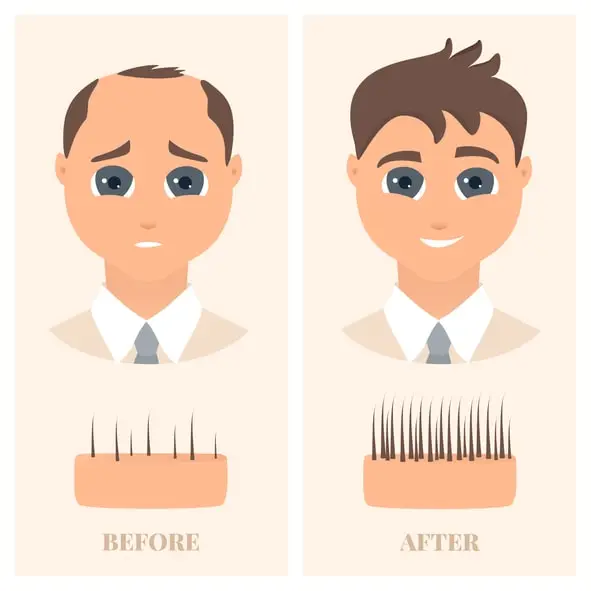
Hair transplants are booming, but equally many people still have reservations about undergoing hair surgery. This is mainly due to the lack of information about the myths, misconceptions and missing facts.
Since 2004, Hairforlife Andreas Krämer has been dealing exclusively with the topic of hair transplantation as an expert and would like to enlighten you below about the twenty most common misconceptions/myths and important facts about hair transplantation:
Myth 1: With a hair transplant, an infinite number of hairs can be removed and transplanted
Hair transplantation is merely a relocation of hair. In the process, hair follicles are implanted from hormone-insensitive areas (donor area/ donor area) into previously hairless regions or between existing hair roots to thicken/fill the hair. The aim of hair transplantation is to redistribute hair in the most skilful and visually appealing way possible, so that the result is visually improved to the maximum. The hair available for harvesting, i.e. the harvesting area/donor area, is only available in limited numbers, if too many hairs are taken from it, it would no longer look visually attractive, similar to a moth-eaten hair. Therefore, the responsible surgeon always provides for appropriate precautionary reserves in case further transplants can remedy more advanced hair loss and the donor area still looks visually appealing and not too thin.
Myth 2: Hair transplantation can be used to transplant another person’s hair or artificial hair
Numerous affected persons who suffer from hereditary hair loss and wish to transplant hair, but are not eligible for the operation because the prerequisites of a still intact donor area are not present and therefore too little donor hair is available, often enquire about the extent to which a foreign hair transplant can be carried out.
However, it became clear many years ago that a transplant with artificial hair or foreign hair (from another person) is not feasible or only very limited and problematic. The problem is that artificial hair, just like other people’s hair, is not accepted by one’s own body.
To prevent the body from rejecting the foreign hair (artificial hair), it is theoretically possible to take medication, for example, immunosuppressants, which include corticosteroids, similar to those used in heart transplants, for example. However, these drugs would have to be administered for the rest of the patient’s life, and the long-term use of drugs is associated with risks and adverse effects, and these are disproportionate to the benefits in a non-essential/non-life-saving operation, so to speak, such as a heart transplant, where the life and death of the patient is at stake.
Due to the risks of permanent scalp infections and generally negative experience, transplantations of artificial hair have been gradually abandoned.
Myth 3: Hair transplantation is only available for men
People still think that only men are affected by hereditary hair loss, receding hairline and baldness. However, this is not the case and more and more women are also affected by typical hereditary hair loss and, as a logical consequence, they also suffer from the consequences, such as thinning hair (often middle parting), receding hairline or a high forehead.
Myth 4: Hair restoration can be performed by all women and men without any problems
First: Yes, hair transplantation is “applicable” for both women and men, but no, unfortunately not in every case!
However, it is important first and foremost that the hair loss has been exclusively inherited and that the donor region has remained intact (sufficient donor hairs are available!
Surgical intervention in women is possible for alopecia androgenetica (AGA – classic hereditary hair loss) of the male type with receding hairline (receding hairline) and of the female type with middle parting light pattern according to Ludwig.
If there is pathological hair loss, surgery is ruled out in the vast majority of cases. In the case of circular hair loss/alopecia areata, on the other hand, only if the bald areas are small and the hair loss is absent for more than 1 year after therapy.
Myth 5: One hair surgery is enough for a lifetime
No. In the majority of cases, a single operation is not enough for a lifetime. If, for example, the corners of the receding hairline are planted and more hair is lost behind them due to hereditary hair loss, these areas must also be transplanted. Theoretically, it is possible not to carry out any more surgery, but this would result in unsightly devil’s horns, which are not visually attractive. In the majority of cases, therefore, after a “first” hair transplantation has been carried out, further operations must regularly be carried out in later years. How many operations are necessary in total, however, depends on the hair situation that is achieved.
Myth 6: A hair transplant is painful and you will be in pain for a long time after surgery
For many women and men, one of the main concerns is pain. It is true that hair transplantation is an operation that does not require a full anaesthetic and, especially with the FUE technique, it is a minimally invasive procedure. However, unfortunately, both FUE and FUT surgery/strip hair transplantation are not completely painless. Nevertheless, the vast majority of people who have already had a hair transplant feel similar to a dentist. The areas to be treated (receiving and harvesting area) are locally anaesthetised beforehand, although a slight puncture with some pain is unavoidable. After the anaesthesia, however, you no longer feel anything from the actual procedure.
How the pain behaves immediately after the operation must be differentiated according to which method is used.
- Follicular Unit Extraction (FUE) :
Even though an FUE only leaves fine wounds, there are still many small wounds that have to heal after the operation. Up to a few days after the procedure, you may experience slight pain here and there, which can usually be managed well with painkillers such as paracetamol, ibuprofen, etc. It is also possible that the skin will be a little tense or sore for a while. It can also happen that the skin is somewhat tense for a while or that there are slight feelings of numbness.
Although only small wound areas are created after an FUE, numerous small injuries must heal after the procedure. A few days after the operation, you may feel some minor pain, which can usually be managed optimally with paracetamol, ibuprofen or similar painkillers. In addition, your skin may be a little tight and painful for a while. You may also feel a slight sensation of numbness. However, all these unpleasant side effects usually disappear after a few days.
- Strip hair transplantation (FUT):
As a rule, you may feel slight pain in the area of the strip removal in places up to a few days after the treatment, but this can be kept within limits with painkillers in the form of ibuprofen/paracetamol, etc. In the case of a strip transplant, the donor area could still be tense for a few weeks to months (a piece of skin was always removed and the wound was closed with more or less tension – depending on the extensibility of the scalp) and there may also be a feeling of numbness for a few weeks. Possible side effects such as inflammation of the scar are very minor, but cannot be avoided and may require the use of antibiotic creams, which must be discussed individually with the doctor.
Myth 7: Hair transplants always look unnatural and can be seen from far away
No. Performed by experienced, specialized hair transplant doctors with years of experience, today’s results are very natural and precisely cannot be recognized from afar.
It is important to ensure that the direction of growth is correct, that the hairline is not straight as if drawn from a ruler, that an appropriate density of hair is transplanted and that only fine 1 hair grafts are transplanted in the front rows.
When these important factors are considered, the results of hair transplantation today are very natural.
Example 1 of a naturally transplanted hairline
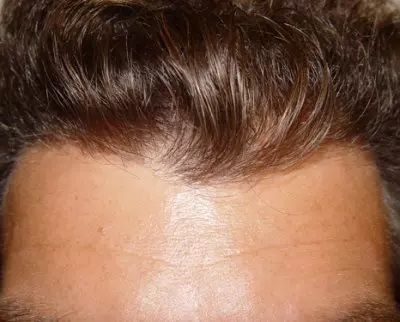
Example 2 of a hairline that is not recognisable as transplanted and looks natural
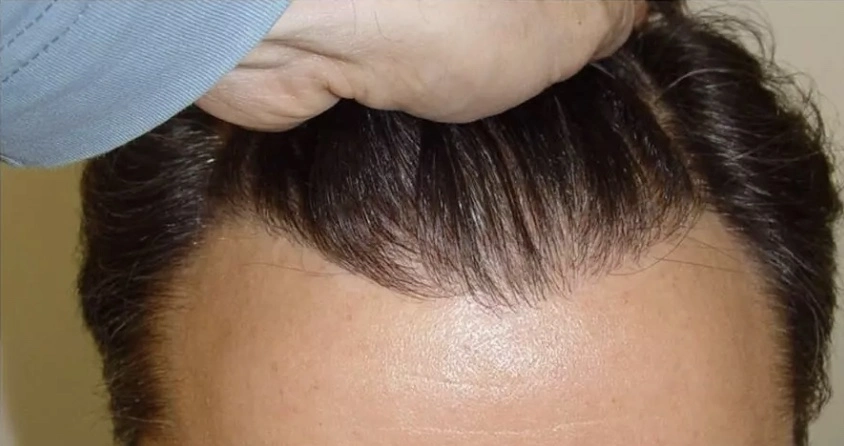
Warnung/Achtung!
The situation is quite different if the operation is performed by doctors with little know-how and experience, or even if the operations, as is often the case in low-cost chains, are not performed by doctors but by auxiliary staff without any medical training!
Then hairline can look very unnatural as a result, with large grafts in the hairline, wrong direction, unsightly design and what looks like a brush. Such miserable results are then very much recognizable as “transplants” and this often from a distance.

Myth 8: Large and ugly scars appear after hair transplantation
No: Again, with experienced, specialised hair transplant doctors, performed with years of experience, there are usually no large and ugly scars!
However, it is also a fact that there is no hair transplant, regardless of the method, that does not leave scars!
However, the resulting scars must be differentiated in the respective technique:
- Follicular Unit Extraction (FUE) :
In the FUE method, the follicular units of the hair are extracted step by step from the extraction area using tiny punches with a diameter of 0.7 – 1.00 mm:
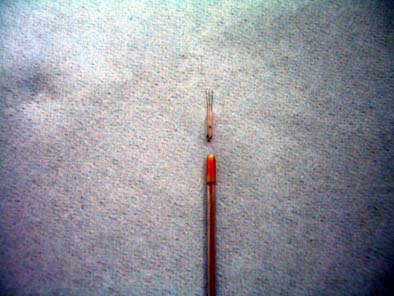
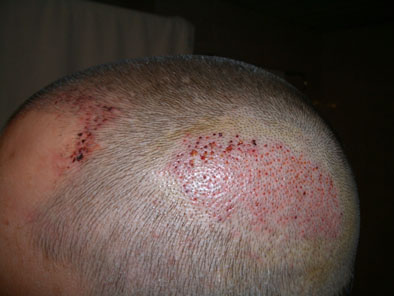
On the net, people often speak of a scarless technique for an FUE transplant. This is actually not correct! Although it is a less invasive technique and only small injuries occur, and these are – if the procedure was performed by skilled surgeons – often not even visible to outsiders, there are still fine and small scarring.

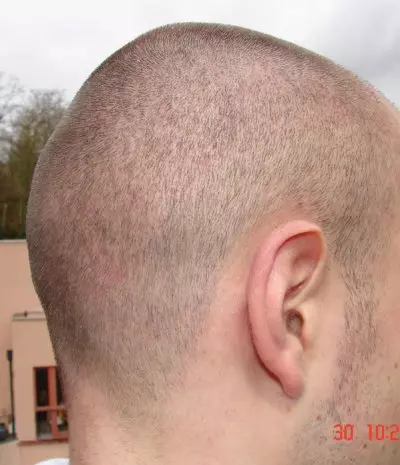
Warning/Caution!
Again, of course, the situation is quite different when an FUE hair transplant is carried out by doctors with little know-how and experience, or even when the operations, as is often the case in low-cost chains, are carried out not by doctors but by assistants with no medical training whatsoever!
As a result, donor areas can look completely decimated and moth-eaten, which also makes follow-up treatments almost impossible.
Here is an example of such a failed extraction with FUE:
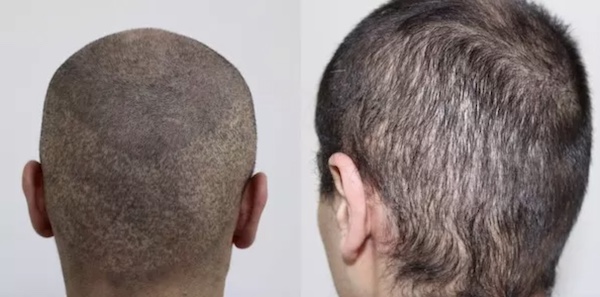
Streifenhaartransplantation (FUT):
In contrast to the FUE procedure, the extraction of the follicular units in a strip transplantation is not carried out individually. Instead, the follicular units are extracted from the donor region with the help of an appropriate microscalpel and thus a completely removed skin strip, which is then divided into the individual follicular units/grafts using a high-precision microscope.
After FUT, a straight scar is left on the back of the head, but it is not visible until the hair is trimmed very short.
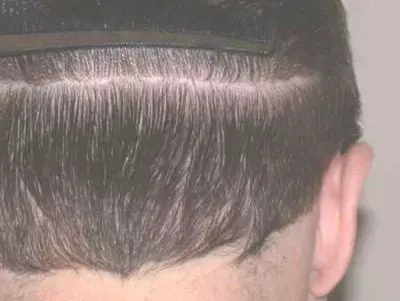
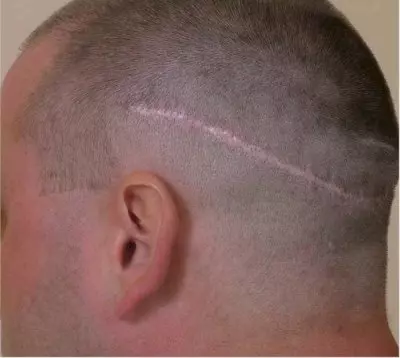
Myth 9: FUE hair transplantation does not produce scars, however
No, as mentioned in Myhtos number 8, scars remain with every transplant, even after an FUE! However, if the operation is carried out professionally by experienced FUE specialists, these are hardly noticeable, even in the short hair condition.
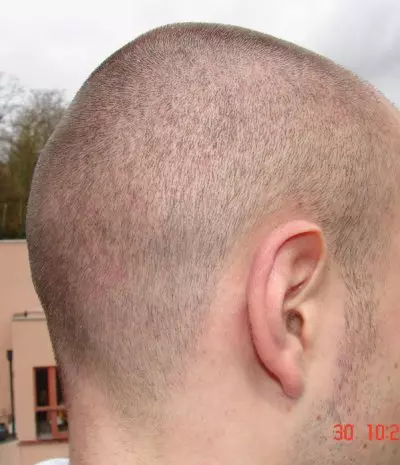
Myth 10: There are no risks with hair transplantation
Yes, it is! Hair transplantation is now often sold on the net as if it were not a real operation and as if risks could almost be ruled out. Possible risks are concealed in order to sell the procedure better.
In fact, however, a hair transplant certainly brings risks with it, especially if it is carried out by doctors with little know-how and experience, as already mentioned several times before. Or if, as is often the case in low-cost chains, they are not performed by doctors but by assistants without any medical training!
Actual risks are:
- Decimated, eviscerated donor areas
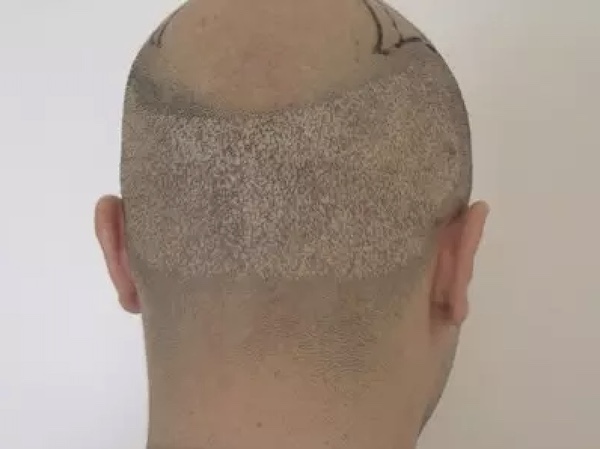
- poor growth rate
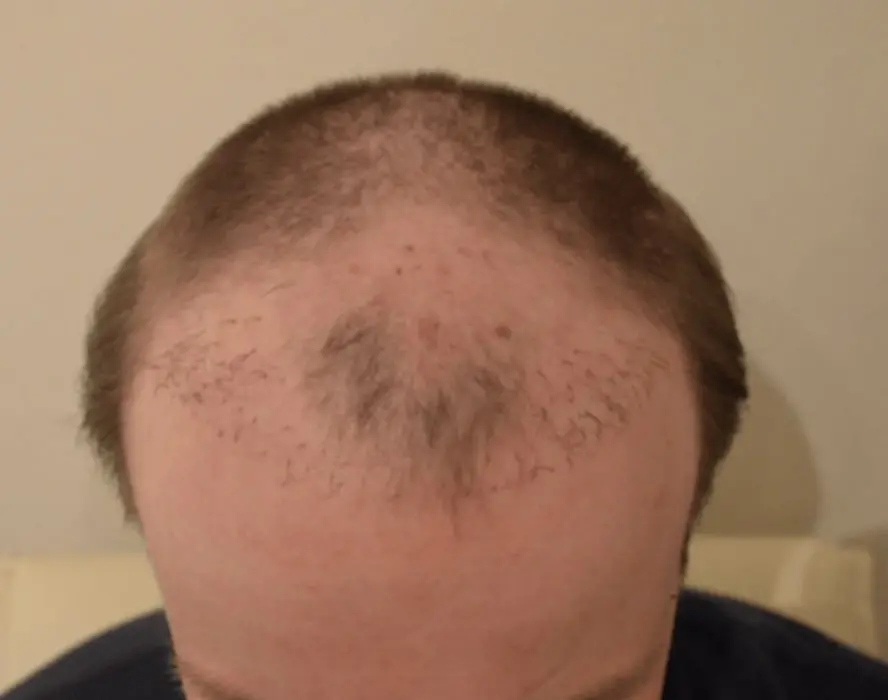
- unnatural hairline with cover grafts at the forefront

- Unattractive scars

Myth 11: Baldness can no longer be treated with hair transplantation
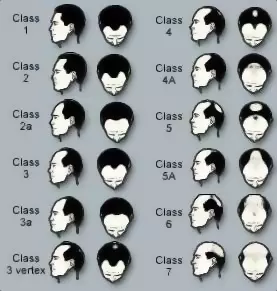
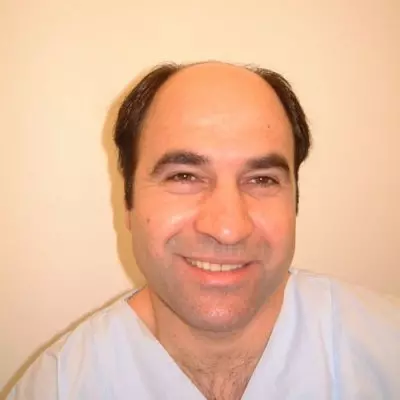
Yes, it is! Baldness with a NW 6 classification is quite possible!
However, it depends on a few factors:
- Expectation, of course you can’t expect a full head of hair like you had when you were 18!
- Size of the bald area
- How many grafts can be obtained from the donor area?
In the case of large bald areas such as a full bald head/NW 6 classification, it can always happen that even larger areas remain unplanted. However, this alone does not mean that hair transplantation is ruled out, but in many cases the expectations must be adjusted and beautiful optical changes and results can still be achieved!
Just having hair grow back in the first third, with a nice natural hairline that frames the face again, can make great visual changes, even if areas are otherwise left unplanted.
Myth 12: Transplanted hair needs special treatment or medication
No, this is not true! Transplanted hair can be treated normally, it is your own “real” hair that has only been redistributed. After a hair transplant, you can do everything with your hair that you have always done.
It is also not true that you have to take medication after a hair transplant. No. The transplanted hair will grow even without medication. It is only “recommended” to consider hair loss medication such as Finasteride/Minoxidil, because a hair transplant cannot stop future hair loss, and you will have to be treated again depending on the hair situation. Medication can slow down or even stop future hair loss, so that the next hair transplant needed can be postponed.
Myth 13 Hair can no longer be coloured after surgery
No, as discussed in point 12, transplanted hair does not require any special treatment and the hair can be coloured without any problems.
Myth 14 You can’t get a good result with thin hair
This assertion also does not correspond to the truth. Of course, people with thin hair can also be transplanted. However, it may be that a larger number of hairs/graft must be transplanted for a visually coherent result.
On the other hand, often just the results of patients/people with thin hair are very natural. For people with thick hair, the results are just as natural, at least if only 1-hair grafts were transplanted in the front line. However, the results of people with thin hair may look a tad more natural in comparison, which even the world’s best doctor cannot change and each doctor is, in fact, dependent on the hair factors of each patient. Having thin hair does not exclude hair transplantation at all, but it does have advantages and disadvantages.
Myth 15: Older patients cannot have hair transplants
However, even older patients well over 60 years of age can still be treated. However, apart from the factors already mentioned above, it is mainly the patient’s health status that is important!
Is one in good health? Do you have to take medication regularly? If so, which ones? Elderly patients who regularly take blood-thinning medication, for example, would normally have to stop taking this medication before the operation and first consult with their family doctor to see whether the temporary discontinuation of the medication can be tolerated.
Myth 16: You can get the full head of hair you had when you were 18
No. Dense hair like when you were a teenager at 18 is simply not possible with a hair transplant. As already explained above, it is only a hair redistribution and not a hair increase! However, the aim is to achieve a perfect illusion of almost full hair with the available reserves and the transplanted grafts and particularly skilful and “clever” redistribution. Depending on the conditions of the patient and the experience, know-how and skill of the surgeon, this is often possible, so that spectacular optical changes can be achieved.
Myth 17: A hair transplant is paid for by the health insurance fund or insurance company
No, unfortunately, hair transplantation is not usually covered by health insurance. An exception may be special cases of massive hair loss due to accidents, such as burns, but as a rule the chances of the costs being covered are rather miserable.
Myth 18: The result of one stays forever
Until now, it has always been assumed, and this is also written on countless websites, that transplanted hair grows for a lifetime.
However:
Hair transplantation is based on the so-called “donor dominance theory” in the case of constitutional hair loss. If a graft is removed from a site (the hair crown/donor area) intended for permanent hair growth and transplanted into an area suffering from hair loss, after an initial period of effluvium, it will grow in the other position as long as in the original site. This is the scientific concept of hair transplantation, see also the NCBI article.
Possible “thinning out” of the result with increasing age
It must therefore be mentioned that ring of hairs/donor areas may also “thin out” somewhat with age and at a higher age, especially with a high degree of baldness such as NW 6. In such cases, the result also becomes “thinner” with age.
Myth 19: In any case, all hair must be shaved
No, shaving is not necessary in every case! However, it is a fact that in hair transplantations with the FUE method, the hair is very often fully shaved.
However, there are doctors who 1. leave the hair in the receiving area long and shave out the entire hair crown, or 2. the receiving area is left long and only parts or strips are shaved in the hair crown, or 3. and this is the luxury variant and expensive, no hair is shaved either in the hair crown or in the receiving area, this method is also called Unshaven hair transplantation (however, it is only performed by a few hair surgeons, such as Dr. Mwamba www.ufue-hairtransplant.com).
The following are some visual examples:
- FUE Haartransplantation mit Vollrasur

- Partial shave with strip shave: Hairs in the Receiving area remain long and small strips are shaved in the donor area
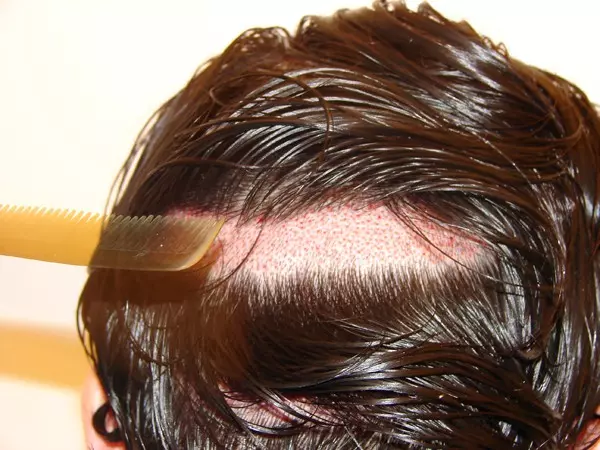
- Partial shave with GJ cut: Receptive hairs remain long and the complete donor area is shaved out
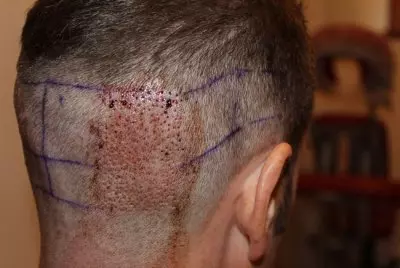
- Unshaven Technique: No shaving is done in the donor area. Only the follicular units are trimmed with special scissors, which are also extracted. All the hair around it remains long
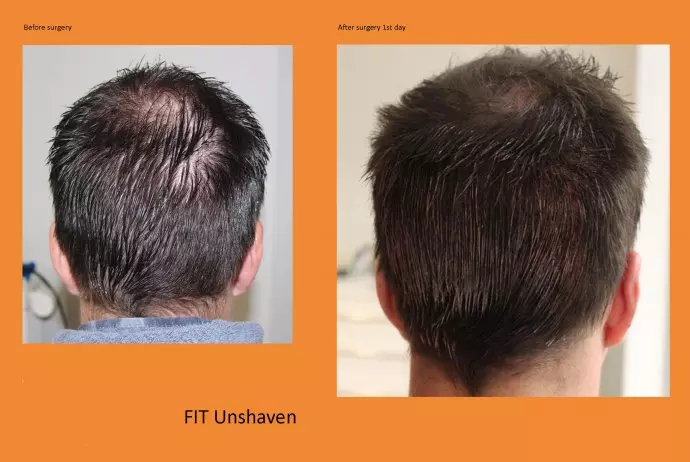
Myth 20: Any doctor can achieve a good result with hair transplantation
No! A successful hair transplant requires a lot of knowledge and a lot of experience.
It is often unknown that the field of hair transplantation is not taught at universities. Even if doctors have been trained as specialists in plastic surgery, hair surgery is an absolutely new field for them! A specialist title is therefore irrelevant and says nothing about the actual quality.
One must not forget that the conditions of those affected are quite different. The structure of the hair, the condition of the scalp, the hereditary factors – these are different conditions that a hair doctor has to know exactly about.
To make the possible differences more clear:
- There are people with entirely different hair structures (thick, fine, straight, wavy or curly hair).
- People with blond, brunette, brown, red, or black hair color.
- Different scalp-hair contrasts, such as a light scalp/light scalp and light hair, or a dark scalp/dark scalp and dark hair.
- People with large and short follicles under the skin
- For some, the follicles lie relatively gently in the skin, for others they sit hard
- There are different directions of growth
- Different densities of scalp hair per sq cm.
- In some, the follicle groups are more extensive, while in others they are less extensive and depending on the follicle density per qcm and the size of the follicle group, among other things, a different size of punch is needed for removal
- Some patients have a greater tendency to bleed during surgery, the others less.
Hopefully I have made it clearer with the above explanations: There are numerous peculiarities that a doctor has to deal with in the context of a hair transplant, which he must be prepared for and be able to deal with.
There must also not be any mistakes in the aesthetics: The result must look as real as possible and fit the patient.
This knowledge only brings the necessary routine and also a portion of artistry.


